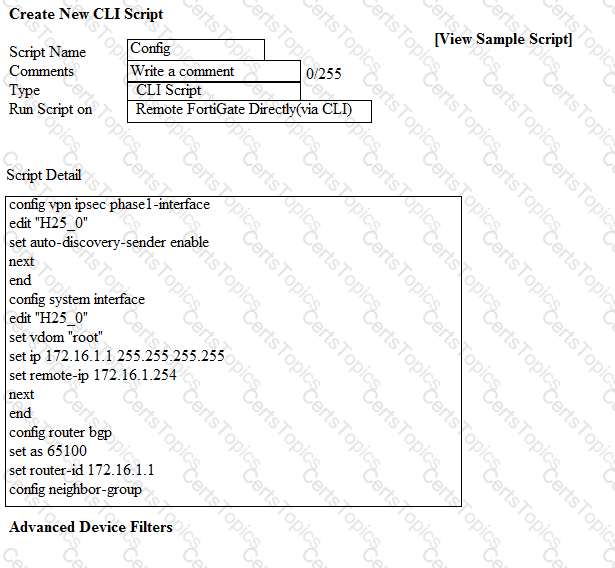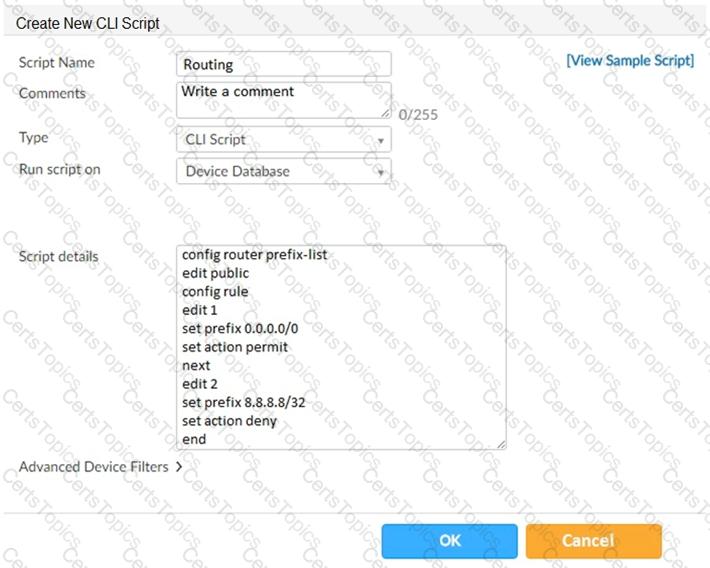Refer to the exhibit.

An administrator is about to add the FortiGate device to FortiManager using the discovery process FortiManager is operating behind a NAT device, and the administrator configured the FortiManager NATed IP address under the FortiManager system administration settings
What is the expected result?
Which of the following statements are true regarding VPN Gateway configuration in VPN Manager? (Choose two.)
Which of the following statements are true regarding schedule backup of FortiManager? (Choose two.)
Which two settings are required for FortiManager Management Extension Applications (MEA)? (Choose two.)
What does a policy package status of Modified indicate?
Refer to the exhibit.

Given the configuration shown in the exhibit, how did FortiManager handle the service category named General?
Refer to the exhibit.

You ate using the Quick install option to install configuration changes on the managed FortiGate
Which two statements correctly describe the result? (Choose two)
In addition to the default ADOMs, an administrator has created a new ADOM named Training for FortiGate devices. The administrator authorized the FortiGate device on FortiManager using the Fortinet Security Fabric.
Given the administrator's actions, which statement correctly describes the expected result?
Which three settings are the factory default settings on FortiManager? (Choose three.)
View the following exhibit.

Given the configurations shown in the exhibit, what can you conclude from the installation targets in the Install On column?
When an installation is performed from FortiManager, what is the recovery logic used between FortiManager and FortiGate for an FGFM tunnel?
Refer to the exhibit.

You are using the Quick Install option to install configuration changes on the managed FortiGate.
Which two statements correctly describe the result? (Choose two.)
View the following exhibit:

Which two statements are true if the script is executed using the Remote FortiGate Directly (via CLI) option? (Choose two.)
View the following exhibit.

What is the purpose of setting ADOM Mode to Advanced?
What is the purpose of the Policy Check feature on FortiManager?
View the following exhibit, which shows the Download Import Report:

Why it is failing to import firewall policy ID 2?
Refer to the exhibit.

An administrator has created a firewall address object, Training which is used in the Local-FortiGate policy package.
When the installation operation is performed, which IP/Netmask will be installed on the Local-FortiGate, for the Training firewall address object?
Refer to the exhibit.

Which two statements are true if the script is executed using the Device Database option? (Choose two.)
An administrator is replacing a device on FortiManager by running the following command:
execute device replace sn
What device name and serial number must the administrator use?
Refer to the exhibit.

An administrator logs into the FortiManager GUI and sees the panes shown in the exhibit.
Which two reasons can explain why the FortiAnalyzer feature panes do not appear? (Choose two.)
Refer to the exhibit.

Which two statements about an ADOM set in Normal mode on FortiManager are true? (Choose two.)
What is the purpose of ADOM revisions?
An administrator configures a new firewall policy on FortiManager and has not yet pushed the changes to the
managed FortiGate.
In which database will the configuration be saved?